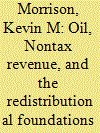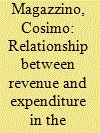| Srl | Item |
| 1 |
ID:
090371


|
|
|
|
|
| Publication |
2009.
|
| Summary/Abstract |
Nontax revenues make up a substantial amount of government revenue around the world, though scholars usually focus on individual sources of such revenue (for example, foreign aid and state-owned oil companies). Using a theory of regime change that builds on recent models of the redistributional foundations of dictatorships and democracies, I generate hypotheses regarding all nontax revenue and regime stability. I argue that an increase in nontax revenue should be associated with less taxation of elites in democracies, more social spending in dictatorships, and more stability for both regime types. I find support for all three of these hypotheses in a cross-sectional time-series analysis, covering all countries and years for which the necessary data are available. Significantly, I show that the particular source of nontax revenue does not make a difference: they all act similarly with regard to regime stability and the causal mechanisms.
|
|
|
|
|
|
|
|
|
|
|
|
|
|
|
|
| 2 |
ID:
134181


|
|
|
|
|
| Publication |
2014.
|
| Summary/Abstract |
The aim of this study is to assess the relationship between revenue and expenditure in the ASEAN countries. Using annual data for the period between 1980 and 2012 in ten member states, a long-run relationship between government expenditure and revenue emerges, both in ASEAN-6 and ASEAN-10 countries. Granger causality analysis shows mixed results, even though for five ASEAN countries the predominance of "tax-and-spend" hypothesis exists, given that government revenue drives the expenditure. Moreover, mixture models seem to produce homogeneous groups, considering the socio-economic structure, welfare state, and historical aspects. Finally, convergence measures show interesting results, confirming the sample's heterogeneity.
|
|
|
|
|
|
|
|
|
|
|
|
|
|
|
|
| 3 |
ID:
031203


|
|
|
|
|
| Publication |
Ithaca, Cornell University Press, 1969.
|
| Description |
xx, 425p.hbk
|
|
|
|
|
|
|
|
|
|
|
|
Copies: C:1/I:0,R:0,Q:0
Circulation
| Accession# | Call# | Current Location | Status | Policy | Location |
| 002495 | 951.5/CAS 002495 | Main | On Shelf | General | |
|
|
|
|